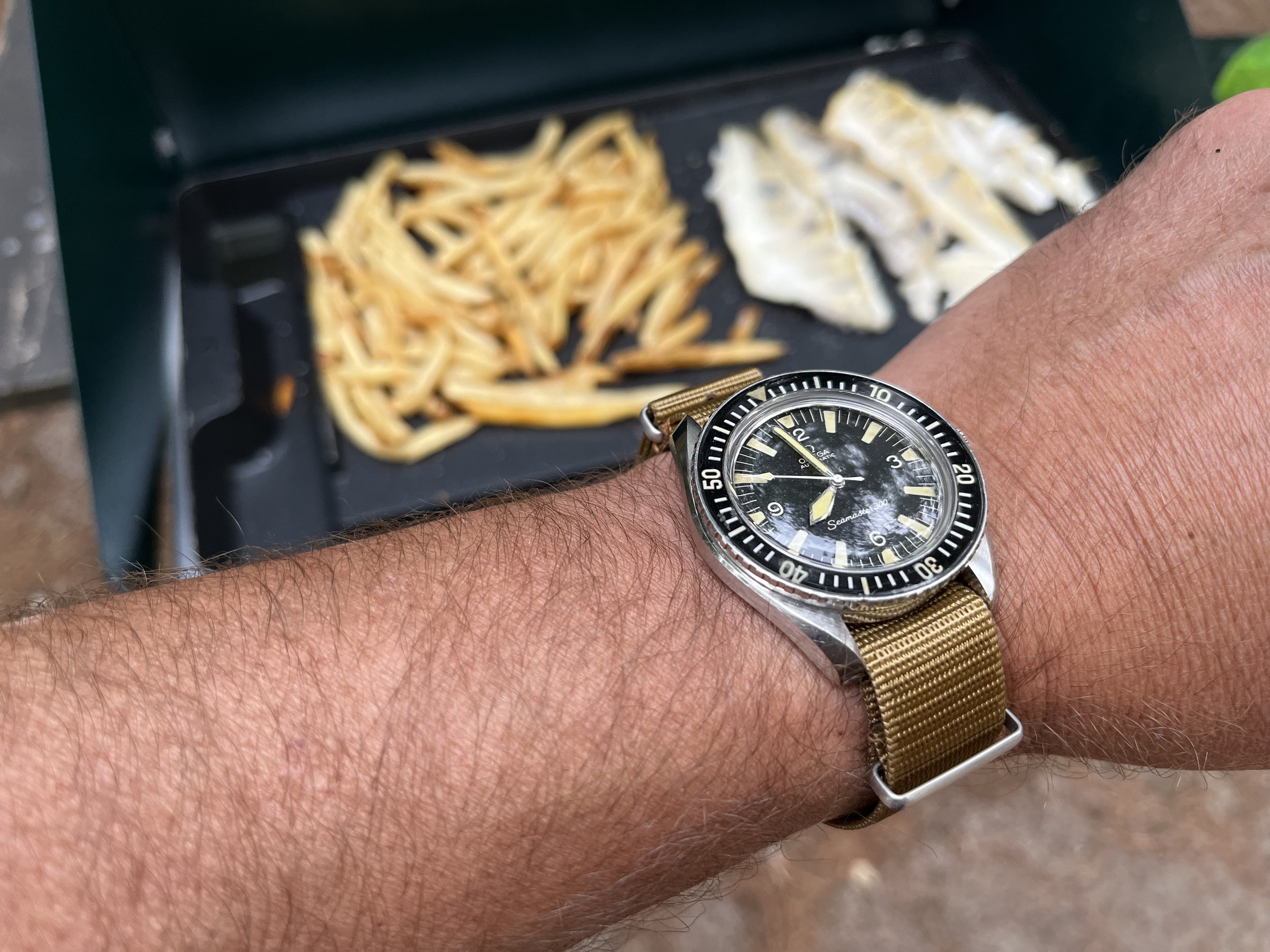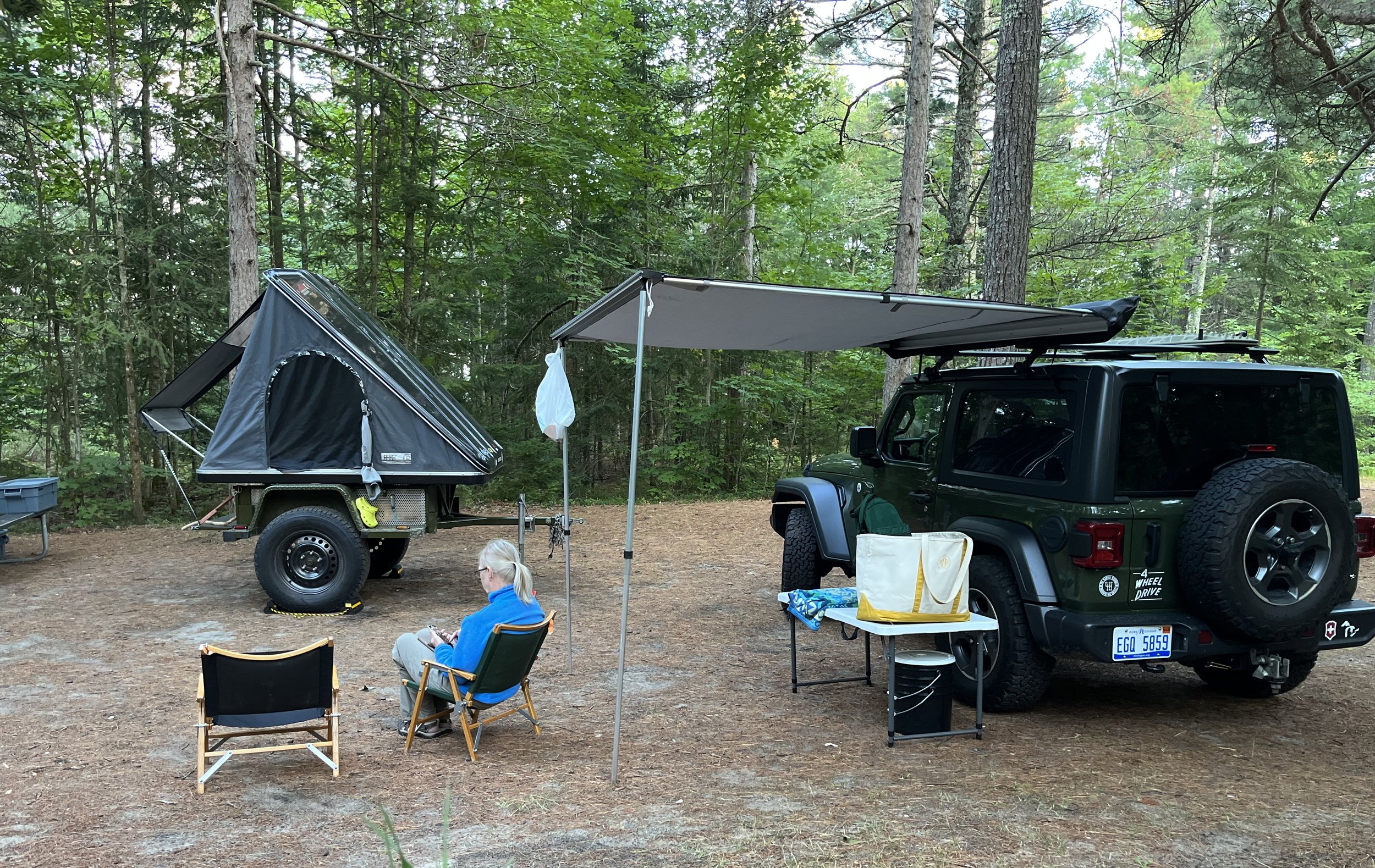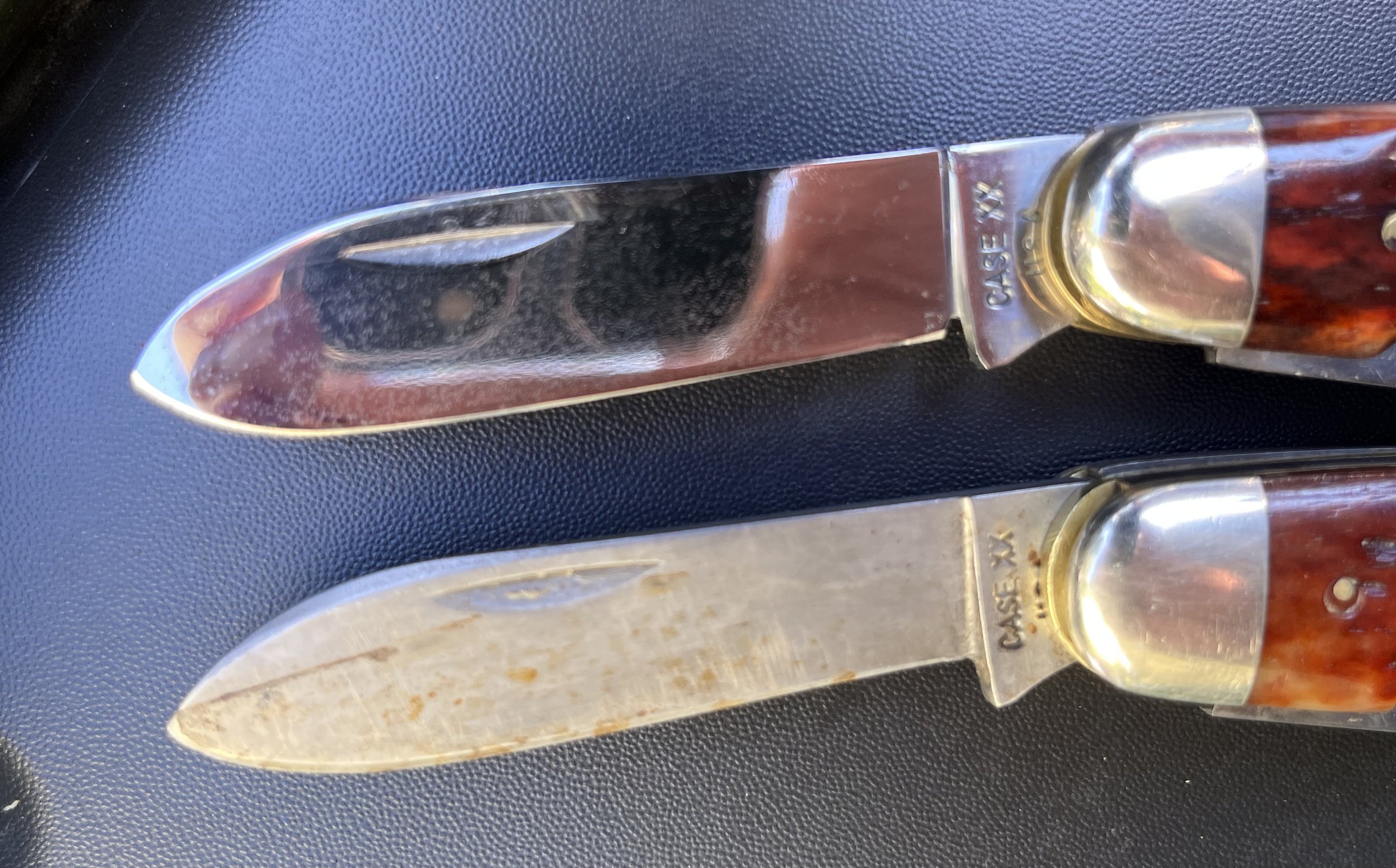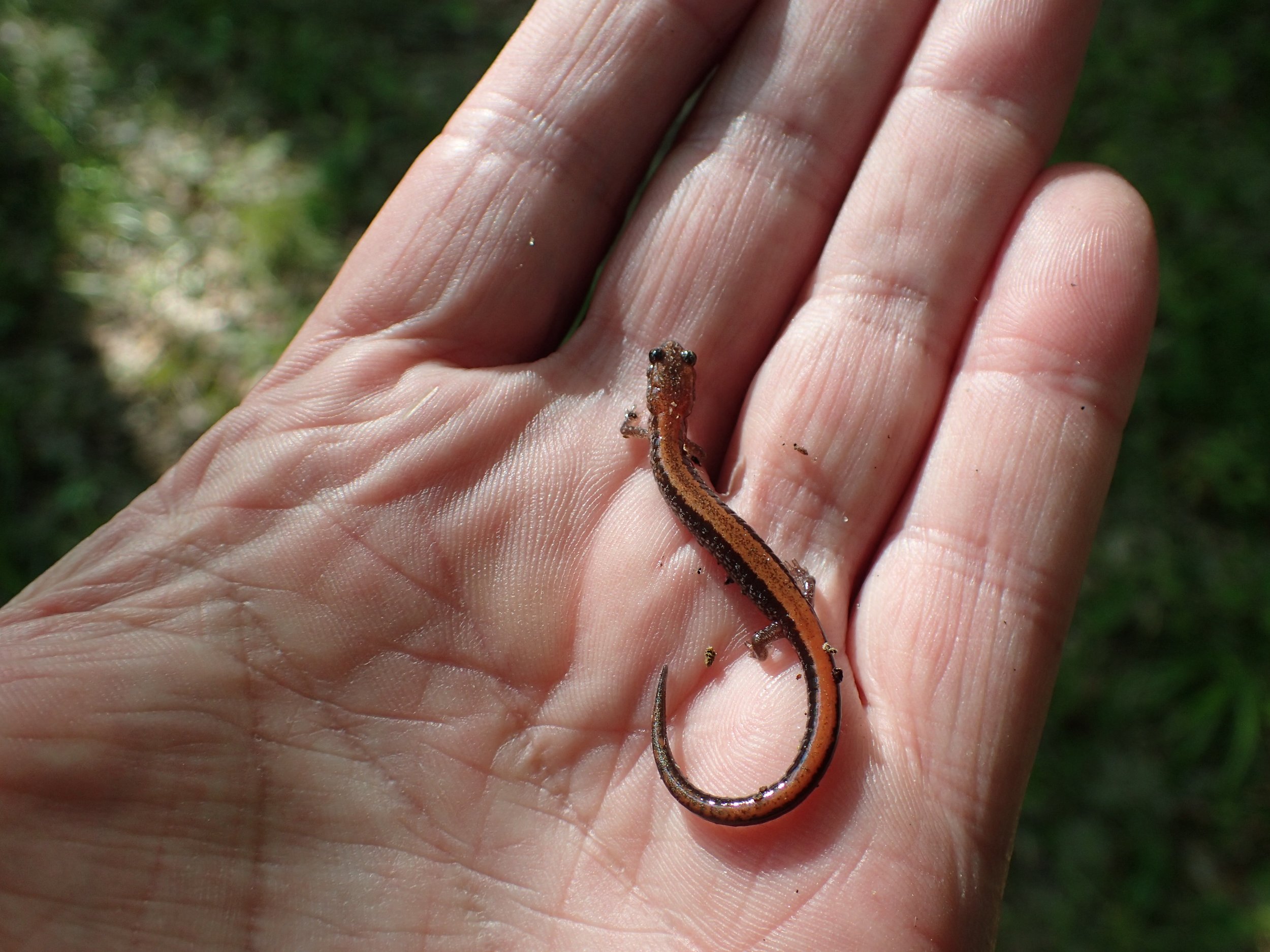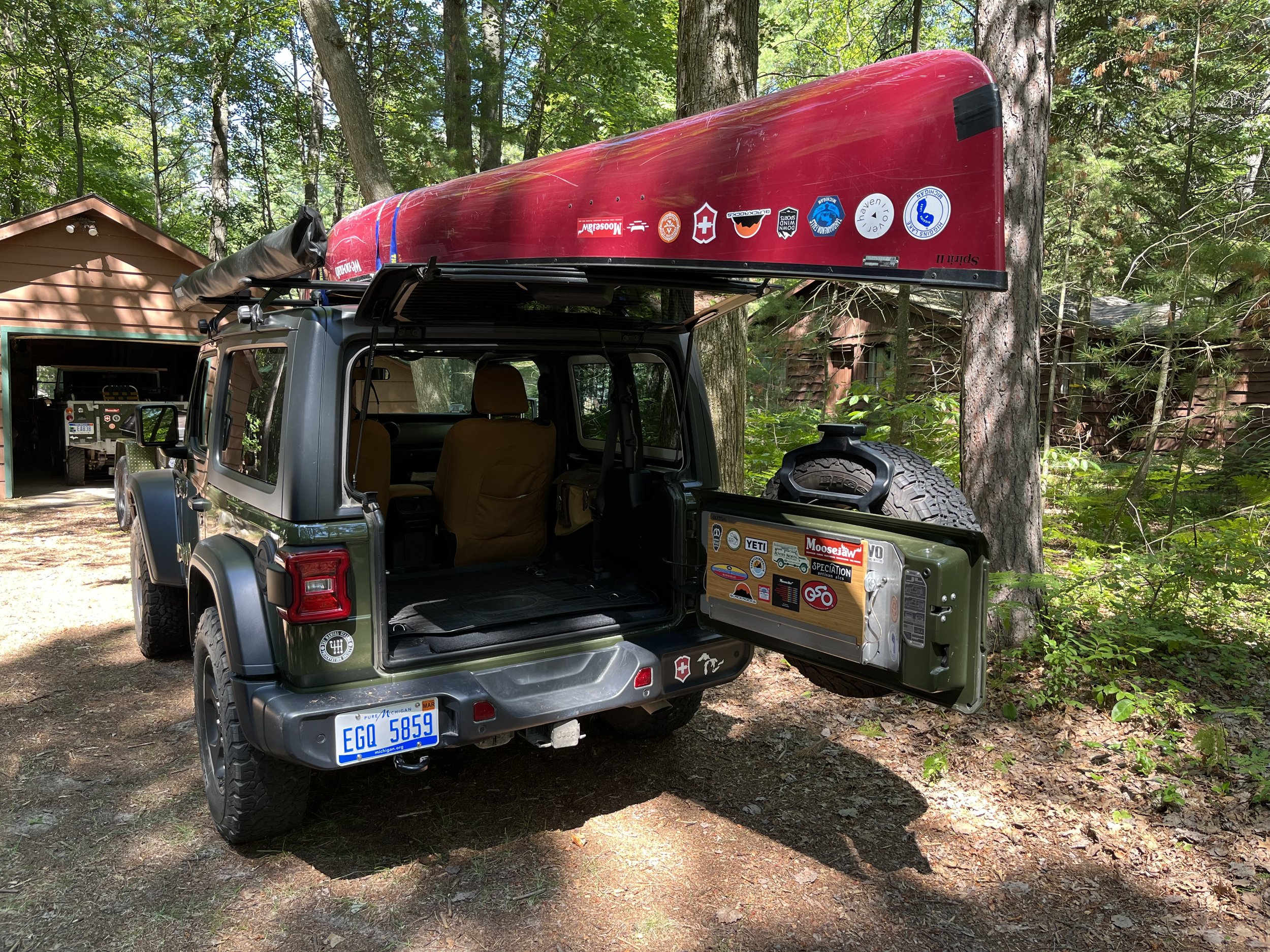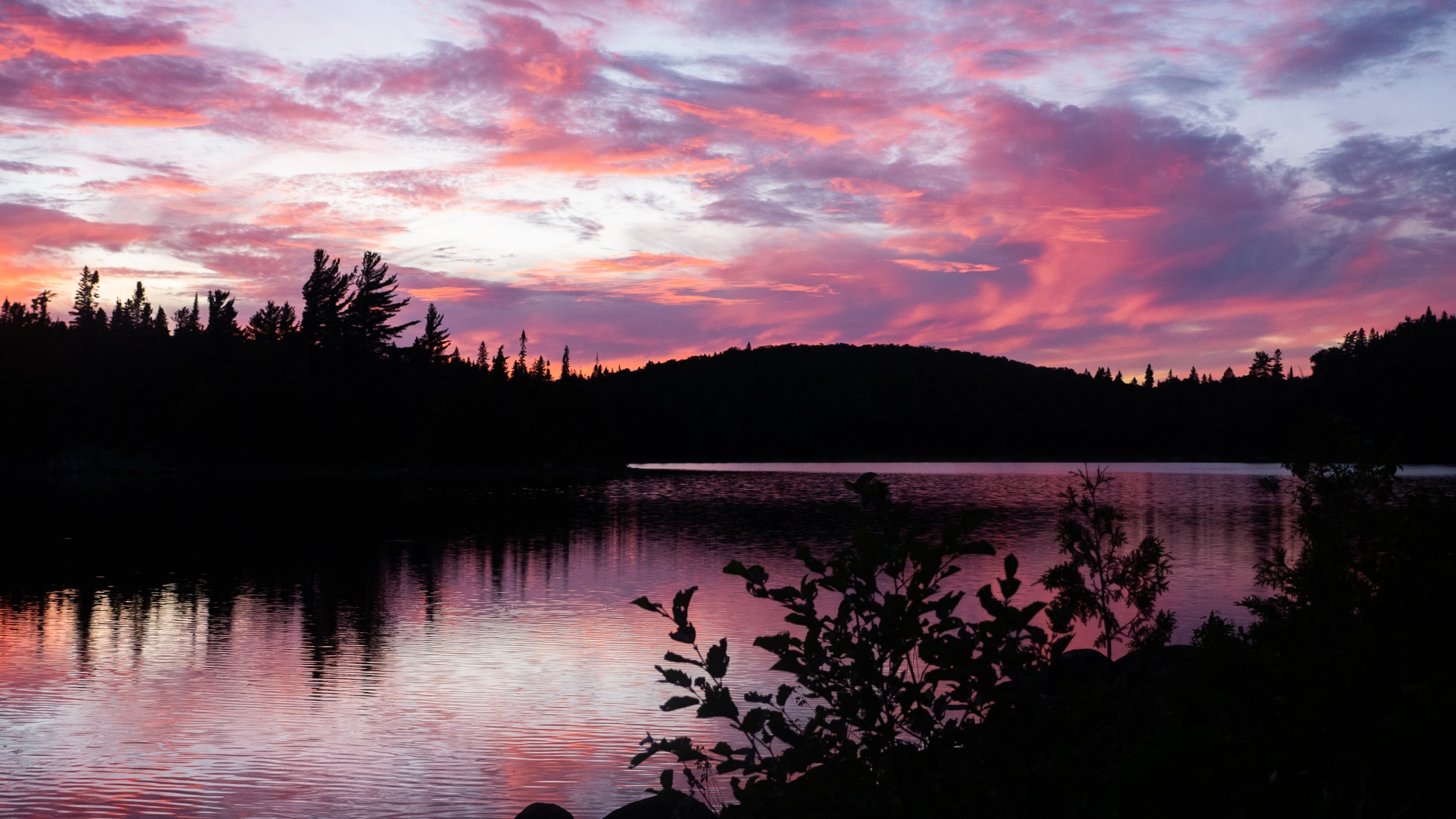Paired for adventure: the Omega Seamaster 300 ref 165.024 and Case 6445R scout/utility knife.
Myron Erickson
Vintage tools for vintage-style adventure.
Most people reach a point when they’re still interested in camping as a means of travel and recreation, but are just kinda done with sleeping on the ground. For me, this point was last year. Our 2021 summer vacation was spent in an AutoHome car-top tent that I mounted to a modified Sherpa trailer. I towed this little camperette behind our short wheelbase Jeep and found the combination pretty unbeatable for camping comfortably while still getting well off the beaten track. The trailer build project was a year in the works and the trip itself only two weeks long, but I used it as the backdrop for reviewing the brilliant Seiko SPB213, which had won me as a fan by trip’s end.
Our DIY camperette, consisting of an AutoHome rooftop tent mounted to a Sherpa trailer.
So this year we decided to take a similar trip with the same setup, find some of our old favorite remote campsites on the shores of Lake Michigan and Lake Superior, explore a few new areas, and then cross into Ontario for a few days of wilderness canoe camping free of both the Jeep and the AutoHome. My camping roots run deep, it turns out, and I’m willing to pay the ground-tenting cost of this kind of experience, for a few nights in the Canadian wilderness, anyway. Fortunately for me the market has provided solutions in the form of super comfy sleeping pads that are also suitable for backcountry travel.
The Great Lakes seen from space, where I am lucky to spend my summer vacations. Image (c) nasa.gov.
Regardless of the concessions to comfort gear I make as I age, I wanted to stay old-school when it came to picking a watch and pocket knife for this trip. I wondered — if it were 1967, what watch/knife combo might I have chosen? I wanted tools that could’ve come from the local family-owned jewelry shop and the neighborhood hardware store, were accessible to ordinary people of ordinary means, and had the horsepower as tools to get the job done. I came up with a pair of favorites that are timeless classics today: the Omega Seamaster 300 reference 165.024 dive watch and the Case Model 6445R scout/utility knife.
The Case 6445R and Seamaster 300, contemporaneous tools paired for adventure.
The watch.
I introduced you to my Seamaster 300 a few months ago, so if you’re wondering about its origins with me, they are well documented, and, I like to think, a little karmic. And I need to confess right out of the gate that I knew I’d be cheating just a little on this part of the challenge. The watch is simply too rare, too nice, and too irreplaceable to risk 24/7 no-holds-barred trial by fire wrist assignment, solely in my attempt to conjure the complete 1967 wearing experience. So, for example, I wouldn’t be taking it swimming or cliff jumping, but I planned on wearing it for nearly everything else. But don’t worry: I brought along a suitable stand-in for the riskier activities, the modern “Heritage”Seamaster 300 caliber 8912. Consider it bonus content for you, the reader, rather than me giving short shrift to the vintage Seamaster.
The Seamaster 300 ref 165.024, a classic diver’s watch from the 1960’s.
The knife.
I’m on the record as a die-hard Victorinox Pioneer guy. I don’t actually know how many Pioneers I own, but the number is sufficiently large to be embarrassing, and if you include the Model 1961 and numerous Pioneer variants, then I’m sure it qualifies me for not-guilty-by-reason-of-insanity legal defenses. So the Pioneer would have been the predictable choice, but I was in the mood for something different. I knew I wanted a simple and robust American-made scout/camp knife with the traditional 4-blade setup à la the Pioneer, and it had to be period-correct to be compatible with the ca. 1967 Seamaster. So I poured a neat bourbon, gazed at my collection, and pondered my options.
L to R: Ka-Bar 1152, Western 901, Boker USA 9361, and Case 6445R.
After a second bourbon, a short list of candidates emerged:
Ka-Bar 1152
Western 901
Boker USA 9361
Case 6445R
The Case 640045R would have also qualified, and in fact was probably more of a direct competitor to the other knives on the short list back in the day when they were all available new. Like them it has jigged Delrin scales, and although it was sold alongside the 6445R, the 640045R was contract-built for Case and was a less expensive option. It is slightly smaller, slightly lighter duty, and slightly less impressive as a tool. It also uses the conventional post-war lobster claw-style can opener.
The Case 640045R (top) and 6445R (bottom). Note the differences in overall size, can opener style, and scale materials.
By contrast, the 6445R is the OG scout/camp knife from Case. They are very heavy duty (“built like a tank” is a description you’ll often hear), beautifully handmade with scales of jigged bone, and simultaneously occupy space in the vintage and modern realms, hailing from the 1930’s and discontinued in the late 1970’s as they were. When considering my shortlist, it occurred to me that I’d never used the 6445R’s unique style of can opener, and I just really wanted the vintage experience of a bone-scaled knife with a certain late-1960’s vibe.
The trip, Part 1: Lake Michigan.
For the first few days of the trip, we wanted to spend time on the clean, unspoiled beaches of northern Lake Michigan. This late in the summer, the water is very swimmable and the bugs are just about done. Michigan has an amazing system of State Forest Campgrounds, a couple of which are located right on the Big Lake. These campgrounds are small and rustic, sometimes requiring high clearance vehicle access, so the vast majority of modern campers stay away. If you are seeking a primitive, relatively private camping experience and don’t mind a few similarly motivated neighbors, these campgrounds are the way to go.
The Mackinac Bridge, looking south toward Mackinac City.
To find this, though, you must leave Michigan’s Lower Peninsula and cross the Mackinac Bridge into the Upper Peninsula (pro tip: it’s pronounced “mackinaw”). A drive along US-2 will find you enjoying amazing views of the top of Lake Michigan as you drive west and look south. A few hours of travel later, we were enjoying a cold Bell’s Two Hearted on the beach, and had the place to ourselves.
Our campground at the very top of Lake Michigan looking southwest, enjoyed with a brace of Two Hearted’s.
We had stopped at a fish market right on the side of US-2 and bought perch filets, then driven through a Hardee’s for a jumbo French fries. It makes a fine car camping fish and chips, and although I don’t remember, it feels like the kind of trick my Dad would’ve taught us. I was born right in the middle of the 1960’s, before car camping was called overlanding. My parents inspired this kind of wanderlust in all of us and the practical wisdom to go with it. We grilled the perch to a golden brown on the Coleman stove, which is just enough time to reheat the fries through.
Cheater fish and chips, timed to perfection.
As we settled into our camping vibe, I reflected on the state of my technique. I still use a 2-burner Coleman stove, candle-powered Alpine lanterns, and shift my own gears in a simple 4WD vehicle that hasn’t changed a whole heck of a lot since the late 1960’s (ok, the heated seats and Apple Car Play are nice). Although I wasn’t raised camping in one, AutoHome invented the modern rooftop tent in 1958, and it pretty much looks today exactly the way it did in 1967. So the bone-scaled Case and tritium-lumed Omega SM300 fit right in, and with a little imagination we are transported back in time.
Our simple setup, only yards from Lake Michigan.
The Case, the edge of which I had honed to a razor-like sharpness, was a champ, proving its worth over the weeks with all four implements finding honest use. The carbon steel blade of the 6445R has a deep belly that accommodates decades’ worth of sharpening, and its heft and size make its use a very satisfying experience. The particular knife I brought with me is a user/carrier in my collection, so when I compare the blade to those on my more pristine specimens, it’s easy to see the toll that even proper sharpening takes.
Two 6445R’s. Note the substantial blade loss from sharpening on bottom blade compared to unused knife on top.
By contrast, the Seamaster seemed like it was just enjoying the vacation too, happily ticking away and telling the time. After expert service, it keeps on-the-wrist time at +2 sec/day. Its timing bezel came in handy on numerous occasions for cooking, but its age makes it just a tad bit loose so I was careful not to bump it. I was tempted to take it swimming, and have to believe it would’ve been fine, but the thought of waking up to condensed moisture under the crystal was enough to make me think better of it, so I changed out to the Heritage SM300 for my aquatic pursuits.
Best not to swim with the vintage SM300, so I brought along its modern descendant.
Perhaps one of the most noticeable characteristics of the Seamaster is the 19,800 vph frequency of the Omega caliber 552. Its tick, tick, tick is a bit lazy, but serves as a good reminder to slow down and take it easy; there’s no place to go and nothing that needs to be done. In fact, why not open another Two Hearted and go for a swim, it seems to suggest. And I admire this seemingly hereditary family trait, as its descendant, the Heritage SM300, is powered by the co-axial caliber 8912, itself only a bit visibly tickier at 25,200 vph.
The Trip, Part 2: Lake Superior.
After a few days of Lake Michigan bliss, we were feeling the familiar tug of further adventure, so we packed up the Jeep and headed further west and north. We checked into the Landmark Inn in Marquette for a night of city fun, and had the famous whitefish dinner and blueberry wheat ale just down the street at The Vierling. When your pint arrives, the handful of Michigan blueberries they throw into the glass dance around with a kinetic joy, swirling, rising, and falling as the carbonation nucleates and forms bursting bubbles on the berries.
The next morning we took off for our favorite remote site on Lake Superior. Situated on public land but not in a campground, it takes some knowing and 4WD to get there. Just one “overland” enthusiast publishing its location would spoil it forever, so it remains a closely guarded family secret. However, there’s no guarantee that another insider won’t be camped there, so it’s something of a risk to bank on it with no Plan B.
Getting a lakeside fire started at sunset at my undisclosed location on Lake Superior.
We arrived to find our site unoccupied and the Seamaster letting us know we were just in time for happy hour. I had planned Mamie Taylors, and the Jeep’s tailgate table made the perfect bar while the Case made quick work of the limes, smoothly cutting through the tough rind without squashing the fruit and wasting the juice. Another swim, this time in decidedly chillier water, and we were really feeling the Gitche Gumee vibe.
Tailgate bar.
I woke up at 6 AM and ventured down to the lake to watch the sun rise, which it did at 6:36 AM. Other than the obvious lack of all-night lume, the SM300 was brilliant, keeping near-perfect time. I could easily see living with just this watch, perhaps in its WatchCo implementation with modern lume, water resistance, screw-down crown, etc.
Sunrise on Lake Superior.
The Seamaster ticked the time away, leaving my wrist only for the swims, and we spent our days relaxing, sun bathing, and Two Hearting until it was time to leave and prepare for our wilderness paddling adventure in Ontario. After a few days of just hanging out on our private Lake Superior rock, the only other soul we encountered being an Eastern Red-backed Salamander, we once again packed up the Jeep and on our way back we found another fish market, this time buying a Lake Trout filet from a fish caught that same day. Some new potatoes from a local farm stand completed the meal.
Tread lightly!
We found a boring but serviceable campground in the Hiawatha National Forest, and the Case went into action, first testing the potatoes for doneness, then smashing them on the griddle, then cutting our trout filet, and finally opening a can of diced tomatoes for a spicy side dish. I couldn’t believe how well the stubby can opener implement sheared the steel can, its thumb stud providing a fulcrum against the can’s rim. If anything, I preferred it to the classic Victorinox implement because of its smooth entry and exit.
The sturdy Case handles meal prep chores with competent ease.
Fresh Lake Superior lake trout.
The Trip, Part 3: Father-Son Adventure on Lake Mijinemungshing.
The next morning, day 12 of our adventure, we went back across the Mackinac Bridge, this time heading south, to drop off the camperette and exchange it for our trusty Wenonah canoe. I traded camping partners as well, when a long overdue father-son adventure was made possible by an unexpected schedule overlap. A quick adjustment to our gear (goodbye Coleman 2-burner, hello MSR PocketRocket) and we were ready for the rigors of the Canadian backcountry.
The Jeep is a brilliant canoe carrier, as it allows full access to the rear of the vehicle with the canoe mounted.
We had the thrill of crossing the Mackinac Bridge again, but this time we kept going north, all the way to Saulte Ste. Marie (pro tip: it’s pronounced “Soo Saint Marie”). After entering Canada at the Soo with the help of one of the friendliest border agents I’ve ever encountered, we still needed to drive another two hours to get to our destination, Lake Superior Provincial Park, at which point we left the Jeep behind and paddled into the interior of the park.
Lake Mij, looking deceptively small and manageable, has about 20 established campsites accessible only by canoe. Image (c) ontarioparks.com.
I was hoping to find an island campsite that we stayed at 15 years ago in the upper arm of Lake Mijinemungshing, or “Lake Mij” as it is more popularly (and understandably) known. Luck was with us and our site was open, which was good since we’d been in the canoe for about an hour and were ready to get out and open a Moosehead.
The Opinel No. 7, spelling the Case for a bit.
The last time I was on this island was 15 years ago, when some friendly Canadian fishermen we met on the portage trail had given us one of the brook trout they’d just caught. I filleted the fish with my trusty Opinel No. 7, which was already a vintage knife by then, and cooked it for an unforgettable dinner. I still have that Opinel, and, like me, it’s a bit tarnished from honest use and the passage of time. And that same camping partner, this amazing young man who is now old enough to buy the Moosehead we were enjoying, caught a killer wrist shot of the Seamaster and the very Opinel I used to fillet that trout.
Same campsite and same camping partner in 2007 (L) and 2022 (R).
We spent four amazing days stargazing, sleeping in, and exploring by canoe, discovering a lovely waterfall in the process. We talked about watches, pocket knives, canoes, and 4WD’s, the tools that facilitate our adventures. On our last night we enjoyed a whiskey down at the lakeshore and watched the sun setting on our little island campsite. With nothing but the loons and each other for company, I reflected on the passage of the years and think, “I must’ve done something right.”
This concludes my Paired For Adventure feature on the Seamaster 300 and Case scout/utility knife. I hope you enjoyed reading it, and as always I welcome your comments.









